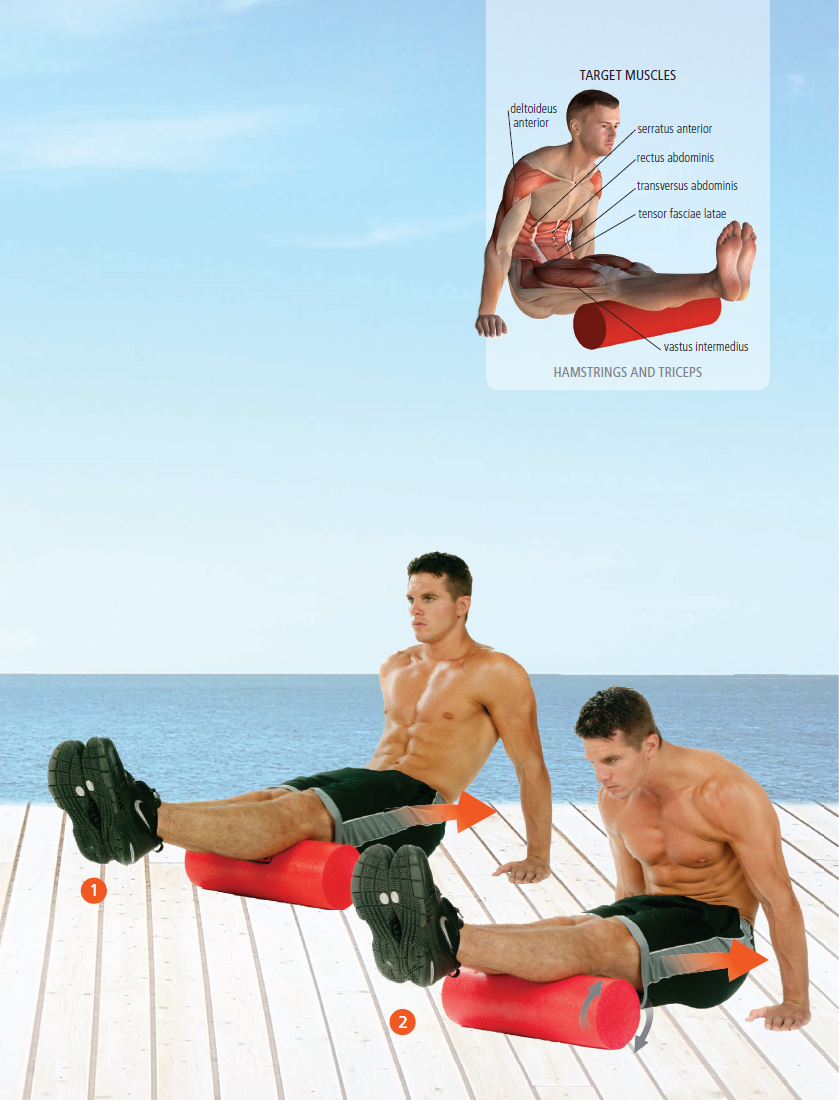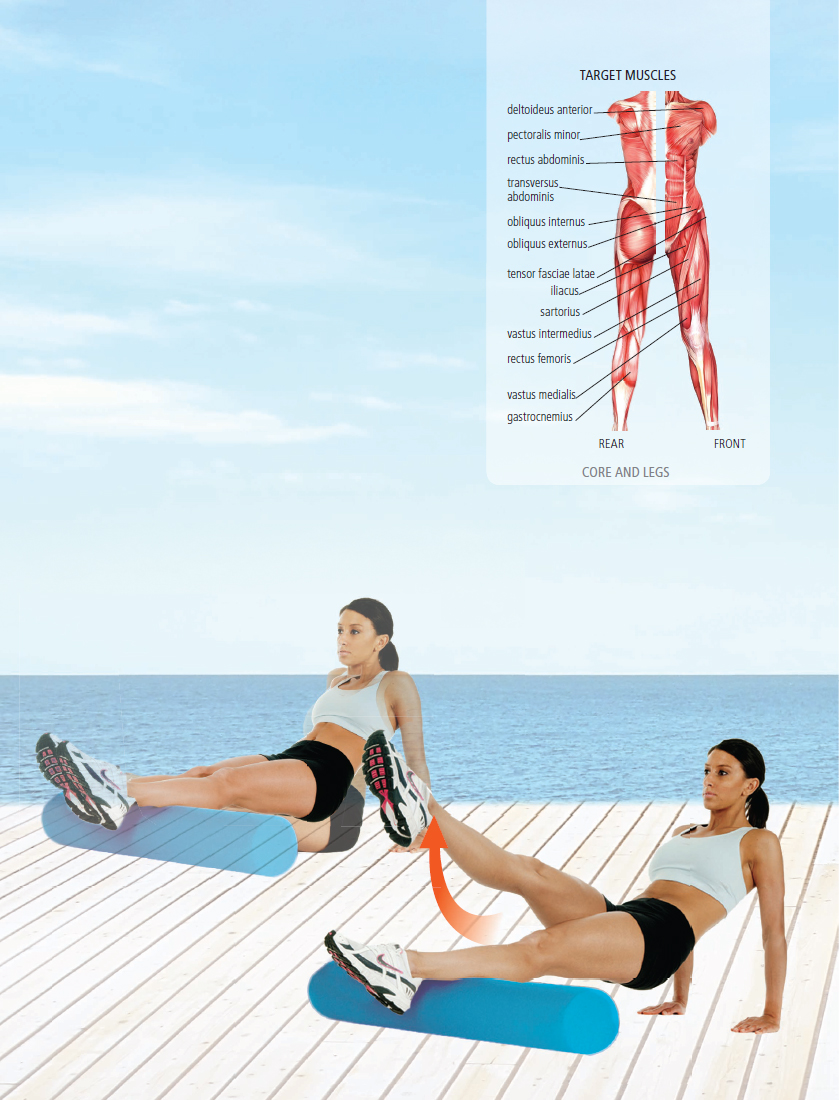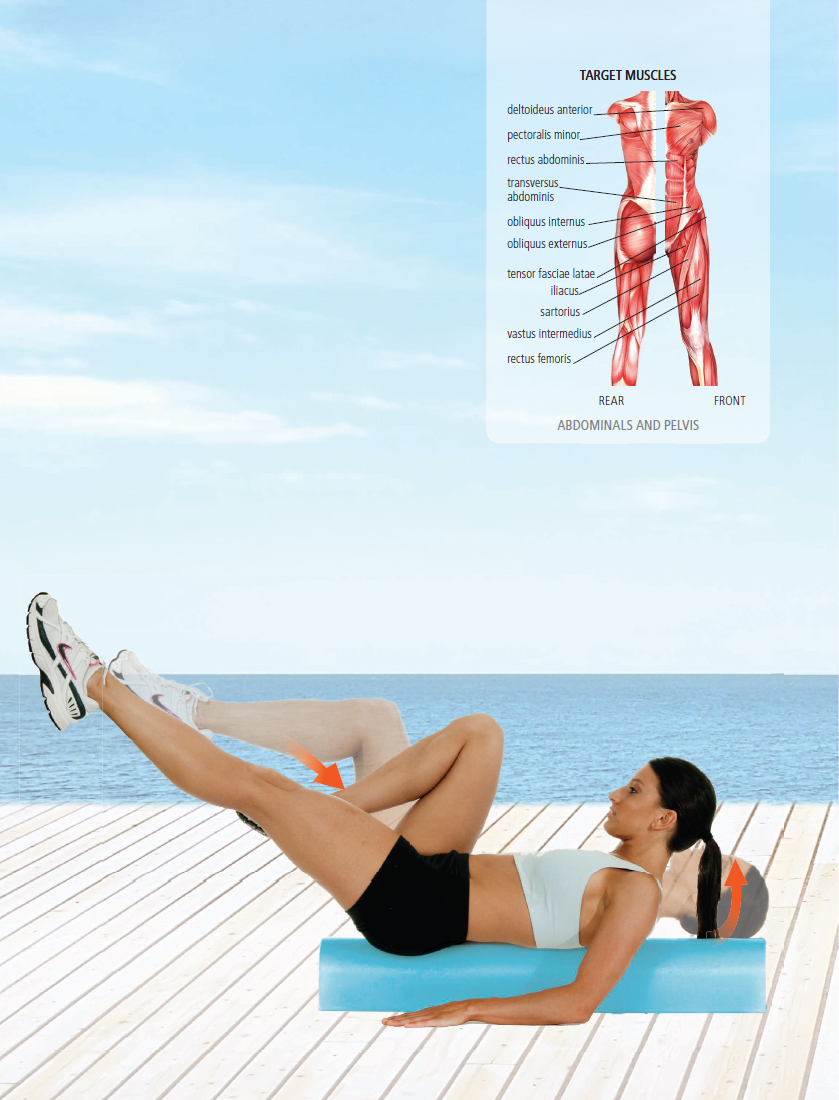It may not look like much, but a foam roller is one of the most valuable, inexpensive, and versatile pieces of exercise equipment out there. It is a great strength-training tool, helping to engage key muscles you want to tone, like your arms, abs, thighs, and glutes, and because the foam roller is an unstable surface, it can replace a Bosu ball or Swiss ball in many exercises, helping to improve your balance and fire up your core muscles.

The Quadruped Knee Pull-In targets your abdominals, thighs, and triceps, and helps improve core stability. Focus on a slow, controlled movement to get maximum benefit from the exercise. It can be made more difficult by bending your arms as you roll in, creating more instability.
WARNING Not advisable if you have shoulder pain, wrist pain, or knee issues.
Step 1 Place the foam roller on the floor. Kneel on the roller, with your hands placed on the floor in front of you. Your hands should be slightly in front of your torso, and your hips should be lifted off your heels.
Step 2 Round out your torso as you pull your knees toward your hands, allowing the roller to move toward your feet. Repeat 15 times for two sets.
CORRECT ACTION
•Round your back as you draw your knees inward
•Relax your head
•Smooth transitions
AVOID
•Allowing your shoulders to lift toward your ears
•Moving your head forward

As its name suggests, the Hamstring Roll is a great workout for your hamstrings, but you’ll also feel a burn in your triceps and abs. Only roll as far as feels comfortable, as the roll-back is more challenging than the roll-out.
WARNING Avoid this exercise if you have lower-back or shoulder issues.
Step 1 Sit on the floor with your legs outstretched in front of you, with the foam roller placed under your knees. Place your hands on the floor to support your torso, your fingers pointing toward your buttocks.
Step 2 Press into the floor to raise your hips, keeping your legs firm.
Step 3 Draw your hips backward through your arms, rolling your legs over the roller. Drop your head so that your gaze is directed at your thighs.
Step 4 Roll on the roller back to the starting position, keeping your hips lifted off the floor. Repeat 15 times.
CORRECT ACTION
•All movement happens at the same time
•Your neck and shoulders remain relaxed throughout the exercise
AVOID
•Allowing your shoulders to lift toward your ears
•Bending your knees as you pull back

The Single-Leg Calf Press is a multifunctional exercise that helps to improve core, pelvic, and shoulder stability. It is a great workout for your shoulders, abdominals, hamstrings, and triceps. If you find the exercise too challenging, don’t raise off the floor.
WARNING Not advisable if you have shoulder pain or wrist pain.
Step 1 Sit on the floor with your legs outstretched in front of you, with the foam roller placed under your knees. Place your hands on the floor to support your torso, your fingers pointing toward your buttocks.
Step 2 Press into the floor to lift your hips, keeping your legs firm.
Step 3 Lift one leg off the roller and hold it steady, making sure not to drop your hips.
Step 4 Keep the leg lifted, and press your opposite leg into the roller, drawing your hips back toward your hands.
Step 5 Return to the starting position, rolling your calf muscle along the roller and keeping your lifted leg straight in the air. Repeat 15 times on each leg.
CORRECT ACTION
•Your lifted leg forms a long, straight line
•Your hips remain elevated throughout the exercise
AVOID
•Allowing your shoulders to lift toward your ears
•Bending your knees
•Bending your elbows

Roller Triceps Dips are a challenging exercise for your triceps. Be sure to have thoroughly stretched your upper arms before attempting it. This exercise also works your abdominals, shoulder stabilizers, and hamstrings, and helps improve core and shoulder stability.
WARNING Not advisable if you have shoulder pain, wrist pain, or knee issues.
Step 1 Sit on the floor with your legs outstretched, the foam roller behind you. Place both hands on the foam roller, with your fingers facing toward your buttocks, elbows bent.
Step 2 Press through your legs and straighten your arms to lift your hips and shoulders.
Step 3 Keeping your shoulders pressed down away from your ears, bend your elbows and dip your trunk up and down. The foam roller should not move. Repeat 15 times for two sets.
CORRECT ACTION
•Your legs remain firm, with your knees straight
•Your neck and shoulders remain relaxed throughout the exercise
•The roller remains firmly pressed to the floor
AVOID
•Allowing your shoulders to lift toward your ears
•Shifting the roller as you move up and down

The Diagonal Crunch targets your triceps, abs, shoulders, and hamstrings. It has the added benefit of helping to improve stability in your core, pelvis, and shoulders.
WARNING This exercise is not advisable if you have back pain or neck pain.
Step 1 Lie lengthwise on the foam roller so that it follows the line of your spine. Your buttocks and upper back should both be in contact with the roller.
Step 2 With your legs straight and your feet pressed firmly into the floor, extend your arms over your head.
Step 3 Raise your head, neck, and shoulders as if to do a crunch. Leave your right leg and left arm down on the ground, using your hand for support. Raise your left leg and right arm, and reach for your ankle.
Step 4 Slowly roll down the roller, dropping your raised arm and leg. Repeat on the opposite leg and arm. Repeat 15 times on each side.
CORRECT ACTION
•Your legs remain firm throughout the exercise
•Your buttocks and shoulders remain in contact with the roller throughout the exercise
AVOID
•Allowing your shoulders to lift toward your ears
•Bending the knees

The Roller Push-Up helps to improve stability in your core, pelvis, and shoulders. It is a great abdominal exercise, and also targets your chest muscles and shoulder stabilizers.
WARNING This exercise is not advisable if you have lower-back pain, shoulder pain, or neck pain.
Step 1 Kneel on the floor, with the roller placed crosswise in front of you. Place your hands on the roller with your fingers pointed away from you.
Step 2 Press into a plank position, lifting your knees and straightening your legs. Keep your hips level with your shoulders, and without allowing your shoulders to sink, bend your elbows and lower your chest to the roller. Avoid any roller movement throughout the motion.
Step 3 Return to the starting position by pressing upward, straightening your elbows, and maintaining a straight spine. Repeat 15 times for two sets.
CORRECT ACTION
•A single plane of movement, with your body forming a straight line from shoulders to ankle
•Your neck and shoulders remain relaxed throughout the exercise
AVOID
•Allowing your shoulders to lift toward your ears
•Bending your knees
•Raising or lowering your body in segments

Supine Marches create a great workout for your abdominal muscles, and work to improve core and pelvic stability. Performed regularly, you’ll also notice benefits to your quadriceps.
WARNING This exercise is not advisable if you have lower-back pain, shoulder pain, or neck pain.
Step 1 Lie lengthwise on the foam roller so that it follows the line of your spine. Place your arms on the floor by your sides, bending your knees so that your feet rest flat on the floor.
Step 2 Pointing your toes and keeping the hips from lifting or shifting, raise one knee toward your chest.
Step 3 Switch legs, again being careful not to allow your hips to lift.
Step 4 Repeat 15 times on each leg as you establish a smooth “marching” rhythm.
CORRECT ACTION
•Your legs remain firm and your toes pointed
•Your neck and shoulders remain relaxed throughout the exercise
•Your hands and forearms lie flat on the floor
AVOID
•Allowing your shoulders to lift toward your ears
•Allowing your hips and lower back to lift off the roller during the movement

This is a challenging exercise that is designed to release the iliotibial band. It may be uncomfortable at first, but will become easier with repetition. It also works your lateral thigh muscles and scapular stabilizers.
WARNING This exercise is not advisable if you have back pain or shoulder pain.
Step 1 Lie on your left side, with the foam roller on the floor and placed under the middle of your thigh. Support your torso with your left forearm on the floor.
Step 2 Bend your left leg and cross it in front of your right, so that your knee is pointed upward. Place your left foot flat on the floor.
Step 3 Pulling with your shoulder and pushing with your supporting leg, roll back and forth along the side of your thigh. Adjust the placement of your arm as you make your motion bigger.
Step 4 Repeat 15 times on each side.
CORRECT ACTION
•Your shoulders remain relaxed throughout the exercise
•Your hands and forearms press firmly into the floor
AVOID
•Allowing your shoulders to lift toward your ears

The Bridge with Leg Lift is a great exercise for your glutes and hamstrings. Take care performing this movement, as there is the danger of the roller rolling out from under you—keep it in position using your abdominal and thigh muscles.
WARNING This exercise is not advisable if you have lower-back pain, a hamstring injury, or ankle pain.
Step 1 Lie on your back, with the roller under your shoulders. Your buttocks should be on the floor, with your knees bent, and feet flat on the floor.
Step 2 Press into the floor with your feet, and bridge up, lifting your hips toward the ceiling until they are parallel to the ground.
Step 3 Extend your left leg.
Step 4 Raise your left leg up to the height of your knees. Keeping your leg straight and the roller still, raise and lower your hips.
Step 5 Return to step one and repeat with the right leg.
Step 6 Repeat 15 times on each leg.
CORRECT ACTION
•Your extended leg remains straight
AVOID
•Allowing your hips and lower back to drop during the movement
•Arching your back

This advanced version of the Bridge with Leg Lift is designed to help improve pelvic stabilization, strengthen your gluteal muscles, and strengthen your hamstrings. Focus on keeping the foam roller as immobile as possible.
WARNING This exercise is not advisable if you have lower-back pain, a hamstring injury, or ankle pain.
Step 1 Lie on your back, with the roller under your feet.
Step 2 Without moving the roller or arching your back, bridge up, and lift your hips into the air.
Step 3 Keeping your muscles firm, raise your right leg up to the height of your knees, and straighten your raised leg.
Step 4 Try to keep the roller from moving, and raise and lower your hips while keeping your outstretched leg raised. Repeat 15 times.
CORRECT ACTION
•Your shoulders and neck remain relaxed throughout the exercise
•Your extended leg remains straight
AVOID
•Allowing your shoulders to lift toward your ears
•Allowing your hips and lower back to drop during the movement
•Arching your back

The Hamstring Pull-In is far more challenging than it looks at first glance. The difficulty lies in controlling the range of motion of the foam roller. That said, it provides a great workout for your hamstrings and glutes, increasing strength and endurance in both. It also helps to strengthen your pelvic stabilizers.
Step 1 Lie supine on the floor, your knees bent and the roller under your feet.
Step 2 Bridge up, lifting your hips so that they align with the shoulders in a neutral position.
Step 3 Squeeze your buttocks, and pull your calves in and out as you roll the roller under your feet.
Step 4 Repeat 15 times for two sets.
CORRECT ACTION
•Your shoulders remain relaxed throughout the exercise
•Your body forms a straight line from shoulders to knees
AVOID
•Allowing your hips and lower back to drop as the movement is performed
•Arching your back

The Straight-Leg Bicycle improves pelvic stabilization, and is a great abdominal-strengthening routine. It also works your thigh muscles. Try to keep your shoulders as flat to the roller as you can.
WARNING This exercise is not advisable if you have lower-back pain or neck pain.
Step 1 Lie on your back with the roller placed lengthwise under your spine, your buttocks and shoulders resting on the roller. Place your forearms on the floor on either side of the roller to balance yourself.
Step 2 Draw your knees up to a tabletop position, forming a 90-degree angle between your hips, thighs, and calves.
Step 3 Keeping your back flat, lift your head, neck, and shoulders off the roller. Straighten your right leg and pull your left knee in toward your chest, keeping your head, neck, and shoulders lifted.
Step 4 Switch legs while maintaining your balance, imitating the pedaling of a bicycle. Repeat 15 times on each leg.
CORRECT ACTION
•Your neck remains relaxed throughout the exercise
•Fully extend your leg during the downward phase of the “pedaling” movement
AVOID
•Allowing your shoulders to lift toward your ears
•Lifting your hips and lower back during the movement

The Dead Bug doesn’t sound as though it should be especially challenging, but it certainly is! Be sure to do this on a padded mat, as the chances of rolling off are pretty high. It’s worth persevering, though, as it’s a great core-stabilizing workout.
WARNING This exercise is not advisable if you have lower-back pain or neck pain.
Step 1 Lie on your back with the roller placed lengthwise under your spine, your buttocks and shoulders resting on the roller. Place your hands and forearms flat on the floor for stabilization. Draw your knees up so that your legs form a tabletop position.
Step 2 Lift your head, neck, and shoulders.
Step 3 Press the palms of your hands onto your knees, creating your own resistance as you try to balance. Flex your toes and keep your elbows pulled in to your sides. Hold for 10 seconds. Repeat 10 times.
CORRECT ACTION
•Your hips, thighs, and calves form a 90-degree angle
•Your neck remains relaxed throughout the exercise
•Your shoulders and buttocks remain flat on the roller throughout the exercise
AVOID
•Allowing your shoulders to lift toward your ears
•Lifting your hips or lower back during the movement
•Falling off the roller!














